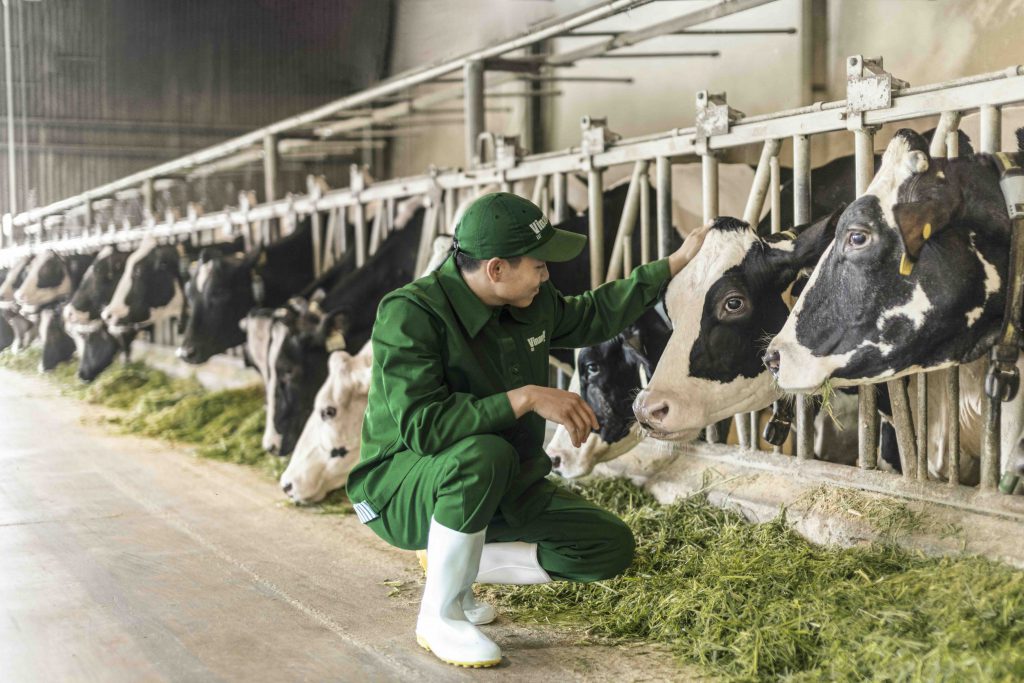Story: Quynh Thuong
Photos: Vinamilk, Chu Quang Minh, Quang Ngoc
The development of livestock farming in Vietnam is not just about upgrading individual products; it marks a decisive step that positions the sector within the broader landscape of modern agriculture.
With a domestic market of 100 million people, ensuring food security alone would already seem a major challenge. Yet livestock farming has achieved much more. On the stock exchange, many enterprises now report annual profits in the trillions of VND, while in 2024, livestock exports reached USD533 million, up 6.5% from the previous year.
Although this figure is still modest compared with seafood or fruit and vegetable exports, it signals that Vietnam’s livestock industry has begun charting a course to the wider seas, moving beyond the domestic cycle of “enough to eat and to wear” and emerging as a new driver of agricultural growth.

A new engine for growth
In Vietnam’s agricultural structure, livestock farming contributes 28–30% of the sector’s total value. More importantly, the industry has undergone a major shift from smallholder household models to concentrated farms and integrated production chains. In 2025, the production value of livestock is forecast to grow by 5.7–5.98%, underscoring the transition toward large-scale commodity production.
Key products have posted notable gains in output. Total live meat production is projected to exceed 8.7 million tons, up 5.3%, including 5.48 million tons of pork and more than 2.56 million tons of poultry meat, up 5.4%. Egg production is estimated at 21 billion, an increase of 4.1%; milk at 1.3 million tons, up 4.8%; and honey at 26,000 tons, up 9.2%. Animal feed production is forecast to surpass 22.05 million tons, rising 2.6% year-on-year.
Beyond volume growth, livestock farming is steadily securing a place on the global export map, with export turnover in 2025 expected to exceed USD550 million, up 3.1% from 2024. Key markets such as China, the US, Japan, and South Korea offer valuable opportunities for the industry.
According to the Ministry of Agriculture and Environment, export turnover of agricultural, forestry, and fishery products in the first eight months of 2025 reached USD45.37 billion, up 12% year-on-year. Within this, livestock products alone accounted for USD410.7 million, a sharp increase of 24.5%.
Vietnam’s livestock industry is making strong strides on the global stage. The country’s pig herd now ranks 5th in the world by size and 6th by output; its poultry flock is the second largest worldwide; fresh milk production leads all of Southeast Asia; and industrial animal feed holds the top position in Southeast Asia and 12th globally.
Export stars
Processed chicken has been a pioneering export, steadily gaining access to markets including Japan (2017), Hong Kong (2019), the five member states of the Eurasian Economic Union (2020), Mongolia (2023), and, most recently, Singapore.
Pork has also begun to establish a presence in Hong Kong and Malaysia, despite challenges such as the African swine fever outbreak that prompted Malaysia to temporarily suspend imports in 2019. Sterilized pork products have entered South Korea, while Vietnam’s poultry eggs and egg products are now available in Singapore, Japan, South Korea, Australia, and several other Asian markets.
A protocol signed with China in April 2019 enabled 11 plants to export milk and processed dairy products to this market, while opening access to more than 40 countries worldwide.
Vietnamese honey has emerged as a standout product, with 80% of output exported to the US, generating an average of USD60-70 million annually. Meanwhile, honey is expanding into Europe, Japan, and South Korea.
Most notably, edible bird’s nests – the “white gold” of livestock farming – have been exported to China since 2022. A new protocol signed on April 15 this year has further opened the market to both clean and raw birds’ nests. Currently, 13 enterprises are licensed to export, marking a major step forward in both value and reputation for Vietnamese products.

In addition, many other specialty products from the sector are strengthening their position in global markets. Fishmeal and fish oil for industrial feed are exported by 25 enterprises to China, accounting for 90% of total exports. Feathers, exported by 34 enterprises to China, make up 80% of total feather exports. Other items such as python skins, buffalo and cow horns, monkeys, farmed crocodiles, and rice bran have also gained access to the Chinese market, creating significant economic opportunities.
A challenging journey
Vietnamese livestock farming now stands at the threshold of unprecedented export and growth opportunities, with ambitions of becoming agriculture’s next “billion-dollar industry.” Yet the path ahead is not without obstacles. To secure access to demanding markets, the sector must overcome three critical barriers: disease control, food safety, and trade negotiations.
Vietnam has yet to establish internationally recognized disease-free livestock zones, while dangerous epidemics pose risks. Strict non-vaccination requirements for meat livestock and poultry make achieving this goal even more challenging.
On the food safety front, domestic monitoring programs remain limited, and major markets like the EU, US, and Japan enforce increasingly strict standards on antibiotic and chemical residues, along with rigorous inspection procedures.
At the negotiating table, as many countries step up protection of domestic production, the issue of “trade-offs” is unavoidable, often with requirements and standards higher than those in Vietnam. These barriers underscore that taking Vietnam’s livestock industry global must be a long-term effort, requiring systematic preparation from regulatory authorities to individual enterprises.
For the livestock sector to develop sustainably, it must focus on six pillars: animal breeds, feed, disease control, science and technology, market development, and environmental protection. At the same time, it is essential to “renew the driving forces of the livestock industry” by expanding high-value species such as silkworms, goats, and sheep, while adapting to increasingly limited farming space caused by urbanization.
The story of Vietnamese livestock today is not only about export numbers or rising output. It is about a sector evolving from meeting domestic needs to building global competitiveness, creating sustainable value, and adding fresh momentum to Vietnam’s agricultural development.
Livestock
Circular No. 17/2020/TT-BNNPTNT, issued on December 28, 2020, defines the livestock sector as: Livestock products include meat (from cattle, poultry, and other farmed animals), eggs, milk, honey, deer antler velvet, hides, feathers, silkworm cocoons, pupae, royal jelly, goat’s milk, buffalo’s milk, cow’s milk, poultry eggs, quail eggs, Japanese quail eggs.
The circular also specifies categories of livestock: cattle (such as buffaloes, cows, pigs, horses, goats, and sheep); poultry (such as chickens, ducks, Muscovy ducks, geese); and other animals (such as rabbits, dogs, pythons, snakes, crocodiles, monkeys, etc.). Aquaculture (fish, shrimp, crabs, clams, etc.) is defined separately as the fisheries sector and is not included in livestock.










